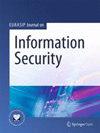利用 ANN 和 KNN 优化物联网设备和数据可用性
IF 2.5
Q2 COMPUTER SCIENCE, INFORMATION SYSTEMS
引用次数: 0
摘要
为了提高物联网设备和数据的可用性,人们进行了大量研究,重点是快速预测瞬时故障率和温度。温度在设备可用性方面起着至关重要的作用,因为它对设备的性能和使用寿命有重大影响。它是预测设备故障的重要指标,并能通过有效的温度管理提高可用性和效率。在针对物联网设备和数据可用性提出的优化方案中,利用了人工神经网络(ANN)算法和 K-Nearest Neighbours (KNN) 算法来驱动神经网络。初步选择了可用性优化算法,并将目标分为两个部分:数据优化和设备优化。为每个部分构建了合适的模型,并采用 KNN 驱动的神经网络算法来求解所提出的优化模型。验证结果清楚地表明了所提方案的有效性。与基准方法、可用性前向容错方法和启发式优化算法相比,最高温度成功降低到 2.0750 °C。此外,物联网设备的平均可用性也得到了显著提高,与上述方法相比,分别提高了 27.03%、15.76% 和 10.85%。三种算法的瞬时故障率分别为 100%、87.89% 和 84.4%。事实证明,该优化算法在消除故障信号和优化限时满意度预测方面非常有效。此外,它在决策过程中还表现出了战略性的前瞻性。本文章由计算机程序翻译,如有差异,请以英文原文为准。
IoT devices and data availability optimization by ANN and KNN
Extensive research has been conducted to enhance the availability of IoT devices and data by focusing on the rapid prediction of instantaneous fault rates and temperatures. Temperature plays a crucial role in device availability as it significantly impacts equipment performance and lifespan. It serves as a vital indicator for predicting equipment failure and enables the improvement of availability and efficiency through effective temperature management. In the proposed optimization scheme for IoT device and data availability, the artificial neural network (ANN) algorithm and the K-Nearest Neighbours (KNN) algorithm are utilized to drive a neural network. The preliminary algorithm for availability optimization is chosen, and the target is divided into two parts: data optimization and equipment optimization. Suitable models are constructed for each part, and the KNN-driven neural network algorithm is employed to solve the proposed optimization model. The effectiveness of the proposed scheme is clearly demonstrated by the verification results. When compared to the benchmark method, the availability forward fault-tolerant method, and the heuristic optimization algorithm, the maximum temperature was successfully reduced to 2.0750 °C. Moreover, significant enhancements in the average availability of IoT devices were achieved, with improvements of 27.03%, 15.76%, and 10.85% respectively compared to the aforementioned methods. The instantaneous failure rates were 100%, 87.89%, and 84.4% respectively for the three algorithms. This optimization algorithm proves highly efficient in eliminating fault signals and optimizing the prediction of time-limited satisfaction. Furthermore, it exhibits strategic foresight in the decision-making process.
求助全文
通过发布文献求助,成功后即可免费获取论文全文。
去求助
来源期刊

EURASIP Journal on Information Security
COMPUTER SCIENCE, INFORMATION SYSTEMS-
CiteScore
8.80
自引率
0.00%
发文量
6
审稿时长
13 weeks
期刊介绍:
The overall goal of the EURASIP Journal on Information Security, sponsored by the European Association for Signal Processing (EURASIP), is to bring together researchers and practitioners dealing with the general field of information security, with a particular emphasis on the use of signal processing tools in adversarial environments. As such, it addresses all works whereby security is achieved through a combination of techniques from cryptography, computer security, machine learning and multimedia signal processing. Application domains lie, for example, in secure storage, retrieval and tracking of multimedia data, secure outsourcing of computations, forgery detection of multimedia data, or secure use of biometrics. The journal also welcomes survey papers that give the reader a gentle introduction to one of the topics covered as well as papers that report large-scale experimental evaluations of existing techniques. Pure cryptographic papers are outside the scope of the journal. Topics relevant to the journal include, but are not limited to: • Multimedia security primitives (such digital watermarking, perceptual hashing, multimedia authentictaion) • Steganography and Steganalysis • Fingerprinting and traitor tracing • Joint signal processing and encryption, signal processing in the encrypted domain, applied cryptography • Biometrics (fusion, multimodal biometrics, protocols, security issues) • Digital forensics • Multimedia signal processing approaches tailored towards adversarial environments • Machine learning in adversarial environments • Digital Rights Management • Network security (such as physical layer security, intrusion detection) • Hardware security, Physical Unclonable Functions • Privacy-Enhancing Technologies for multimedia data • Private data analysis, security in outsourced computations, cloud privacy
 求助内容:
求助内容: 应助结果提醒方式:
应助结果提醒方式:


